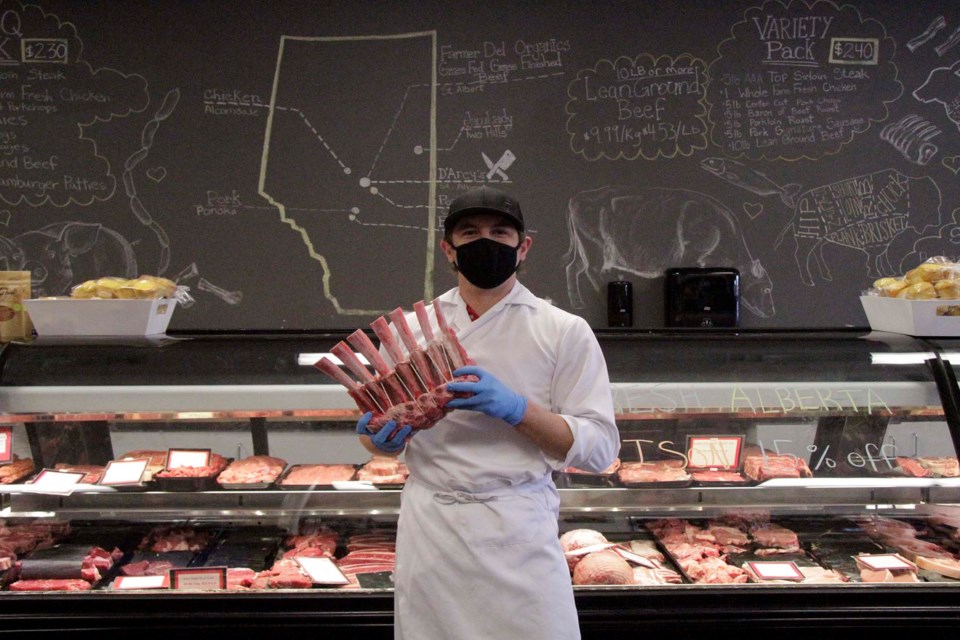As the shop-local trend continues to grow, buying local meat is becoming increasingly popular, too.
Even before the pandemic, reports such as the one produced by Desjardins in 2015 showed that buying local was trending. Once the pandemic began, it appeared to push purchasing behaviour in two directions: local when possible, and online.
The local meat industry has benefited from the trend, though some worry that as the pandemic subsides, so will the increased revenue they have experienced in the last 15 months.
Kyle Iseke, owner of D’Arcy’s Meat Market in St. Albert, said he noticed a big difference at the beginning of the pandemic, particularly as customers saw empty shelves in grocery stores and they started panic buying.
"People would be phoning from the grocery store, and then they would drive down here to purchase. That was the first increase of demand that came with the fear of the unknown," Iseke said.
As time went on and things stabilized to some degree, Iseke said there were a lot of calls through radio and other platforms for people to support local and take care of their own, which he said made a significant difference.
Pandemic aside, Iseke said people who buy from him have always been concerned about where their meat comes from. "People always want to know, do you make this in your own shop, or do you buy it from someone else, where does it come from, but the overwhelming majority are just always happy that it’s an Alberta product, that is their number one concern," said Iseke.
Although the big-box stores still take the most significant share of the market, Iseke said prices might not be the main reason why. With the increased business during the pandemic, Iseke has been able to lower his prices and said they are now in line with stores such as Save On Foods.
However, he said going to the butcher shop is still a special trip, and convenience might keep most customers going to supermarkets where they can source all their needs. Along these lines, the culture of supermarkets in the Western world might also play a part in the preferences shown by consumers.
Brenda and Tony Rustemeier, owners of Lazy RT Beef, where they do custom meat cutting and sell hormone- and antibiotic-free beef, said last year, when COVID-19 hit, and Cargill closed due to outbreaks, they saw an influx of people wanting beef to the point where their own beef wasn't enough. They began to offer the option of beef purchased from local feedlots as long as hormone- and antibiotic-free was not a concern for the client. However, now they said orders have slowed back down to their usual pace.
For the Rustemeiers' customers, getting local products is a priority, along with the extra care that comes from buying from a small local business.
"You can definitely identify a trend there, because people are conscious of buying local products from local people, and they are quite concerned with it being a local product," Tony said.
"There is also an appreciation of individualized service that they get from some of the smaller shops like us," said Brenda.
Christine Mercier, the manager of the Morinville Farmers’ Market, echoed some of the Rustemeiers' sentiments. She said she would certainly agree there has been an increase in customers purchasing local meats. Currently, they only have two meat vendors at the market, but Mercier said she wouldn't see them coming back week after week if they weren't doing well. She said quality is a big part of why people keep coming back and the vendors have a steady business.
"If you buy from a local farmer, the local farmer knows what goes into the product. They (customers) know they are getting value for their money and a good product," Mercier said.
A report done by the Business Development Bank of Canada stated 87 per cent of people think buying local is better for the environment, and 97 per cent said they do it to support the local economy.
The local economic side of the buy-local trend is something that resonates with Tony, who said, "When people buy locally from a producer, they feel like they short the supply chain quite a bit. You're dealing with somebody who is selling into his community or neighbourhood and the buck kind of stops here. There is responsibility for the quality of the work. We get that sense a lot that people walk in here, and they buy with a great deal more confidence."




